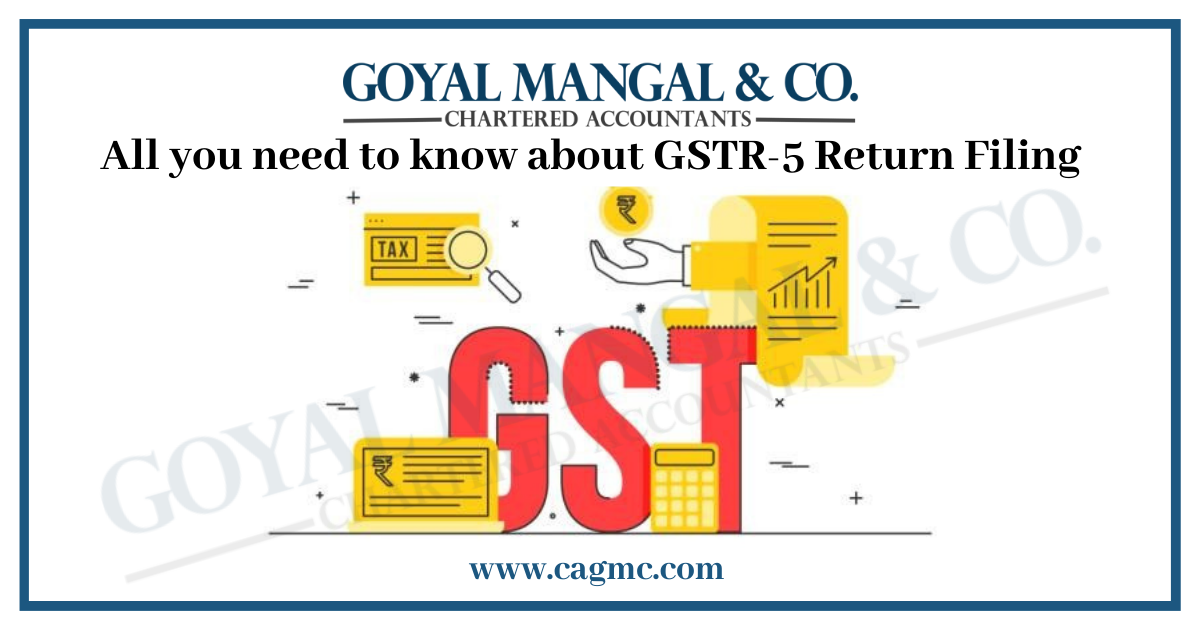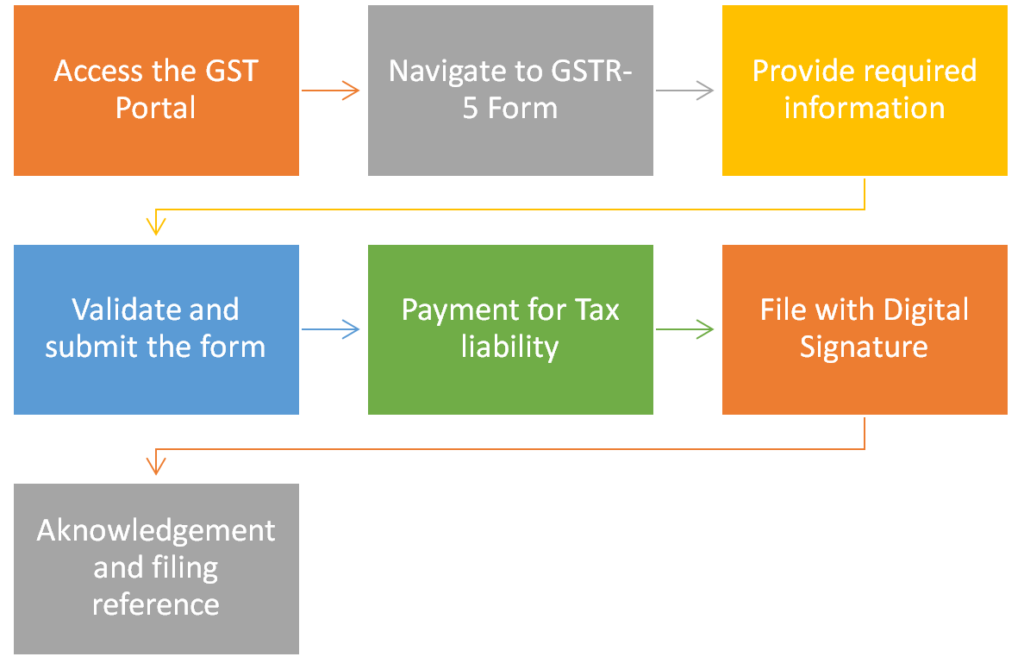
GSTR-5 is a return filed under the Goods and Services Tax (GST) system in India. It is mainly designed for non-resident foreign taxpayers who are registered under GST and provide taxable services in India. Taxpayers are required to file GSTR-5 to report their business activities and fulfil their compliance obligations. The GST regime was introduced in India to streamline the taxation system and bring uniformity across the country. Under GST, businesses are required to file periodic returns that detail their transactions, tax liabilities, and input tax credits (ITC). GSTR-5 is one such return form that non-resident taxpayers must file to ensure transparency and accountability. In this article, we will delve into the GSTR-5 Return filing on GST Portal, along with the requirements.
| Table of Content |
Meaning of GSTR-5 Return Filing
GSTR-5 return filing refers to the process of submitting the GSTR-5 return form under the GST system in India. GSTR-5 is a specific return form designed for non-resident foreign taxpayers who provide taxable services within the country.
Here’s the meaning of GSTR-5 return filing:
- GSTR-5: GSTR-5 is a return form prescribed by the Indian GST authorities for non-resident foreign taxpayers. It is used to report their business activities, tax liabilities, and input tax credits for the relevant tax period.
- Return Filing: Return filing refers to the act of submitting the necessary documents and information related to a taxpayer’s business transactions and tax liabilities to the tax authorities. It is a crucial compliance requirement under the GST system.
- Reporting Business Activities: GSTR-5 requires non-resident foreign taxpayers to report their sales, purchases, and other business activities carried out in India during the specific tax period. This includes providing details such as the value of supplies made, tax liability, and input tax credits claimed.
- Tax Liabilities: Non-resident foreign taxpayers must calculate and report their tax liabilities on the taxable supplies made in India. The tax liabilities are typically based on the applicable GST rates and the value of taxable supplies.
- Input Tax Credits: Non-resident taxpayers can claim input tax credits on GST paid on their purchases or expenses related to their taxable services. GSTR-5 allows them to report and claim the eligible input tax credits accurately.
The purpose of GSTR-5 return filing is to ensure that non-resident foreign taxpayers fulfil their tax obligations, maintain compliance with the GST laws, and contribute to the transparency and efficiency of the GST system in India.
Who is Non-Resident Foreign Taxpayer?
A non-resident foreign taxpayer refers to an individual or entity that is located outside the country but has registered under the GST system in India. These taxpayers provide taxable services within India, making them liable to comply with GST regulations.
Here are some key points to understand about non-resident foreign taxpayers:
- Location: Non-resident foreign taxpayers are individuals or companies that are not residents of India. They are located outside the country but engage in providing taxable services within India.
- GST Registration: To legally provide taxable services in India, non-resident foreign taxpayers are required to obtain GST registration. This registration enables them to comply with the GST regulations and fulfil their tax obligations.
- Taxable Services: Non-resident foreign taxpayers offer services that fall under the scope of GST in India. These services can include consultancy, professional advice, software development, marketing, entertainment, and various other service-based activities.
- GST Compliance: Once registered under GST, non-resident foreign taxpayers are obligated to comply with the GST regulations, which include filing GST returns, maintaining proper records, collecting and remitting GST, and adhering to other compliance requirements.
- GSTR-5 Filing: As mentioned earlier, non-resident foreign taxpayers are specifically required to file GSTR-5, a return form designed for them. GSTR-5 captures the details of their business activities, tax liabilities, and ITC for the relevant tax period.
Who can apply for GSTR-5 Return Filing?
GSTR-5 is specifically applicable to non-resident foreign taxpayers who are registered under the GST system in India. These taxpayers are individuals or entities located outside India but provide taxable services within the country. Here are the key criteria for individuals or entities who can apply for GSTR-5:
- Non-Resident Status: The taxpayer must be a non-resident of India, meaning they are not residing in the country.
- Foreign Taxpayer: The taxpayer must be a foreign individual or entity that is not registered or incorporated in India.
- Provision of Taxable Services: The involvement of taxpayer is must in providing taxable services within India. Taxable services are those that fall under the scope of GST as defined by the GST laws in India. Examples of taxable services can include consultancy, professional advice, software development, marketing, entertainment, etc.
- GST Registration: The non-resident foreign taxpayer must have obtained a GST registration in India. The GST registration process involves providing the necessary details and documentation to the GST authorities and obtaining a unique Goods and Services Tax Identification Number (GSTIN).
Necessary documents require for GSTR-5 Return Filing
Here are the necessary documents and details typically needed for GSTR-5 return filing:
- Goods and Services Tax Identification Number (GSTIN): The unique identification number assigned to the taxpayer upon GST registration is required for GSTR-5 filing.
- Business Details: Information about the taxpayer’s business activities, such as the legal name, trade name (if applicable), and principal place of business, should be provided.
- Sales and Supplies: Details of taxable supplies made during the tax period, including the invoice numbers, invoice dates, customer’s GSTIN (if available), and the value of supplies.
- Purchases and Expenses: Information on purchases and expenses related to taxable services provided in India, including the invoice numbers, invoice dates, supplier’s GSTIN (if available), and the value of purchases.
- Tax Liability: Calculation of the tax liability on the taxable supplies made, including the breakdown of tax amounts for different tax rates (such as CGST, SGST, or IGST).
- Input Tax Credit (ITC): Details of eligible ITC on GST paid on purchases or expenses related to taxable services. This includes the invoice numbers, invoice dates, supplier’s GSTIN (if available), and the value of the ITC claimed.
- Supporting Documents: In certain cases, there may be other necessary documents require for the substantiate transactions of report. Such as invoices, bills, purchase orders.
- Bank Account Details: The taxpayer’s bank account details, including the account number and the Indian Financial System Code (IFSC), should be provided to receive refunds, if applicable.
Step-by-Step procedure for filing of GSTR-5 Return under GST Portal
Here’s an overview of the process for filing GSTR-5 return on the GST:

- Access the GST Portal: Visit the official GST portal and log in using your credentials (username and password).
- Navigate to GSTR-5 Form: Once logged in, click on the “Services” tab, and from the drop-down menu, select “Returns.” Under the Returns dashboard, select the financial year and the tax period for which you want to file GSTR-5.
- Provide Required Information: In the GSTR-5 form, you’ll need to provide various details related to your business activities during the tax period.
- Validate and Submit the Form: After entering all the necessary information, validate the form to ensure that there are no errors or discrepancies. If there are any error, while performing some valid checks in the portal. Then you will be quick to correct them. Once the form is error-free, you can submit it.
- Payment of Tax Liabilities: If you have any tax liabilities, you’ll need to pay them before filing GSTR-5. The portal provides options to make payments through various modes such as online banking, credit/debit card, NEFT/RTGS, etc.
- File with Digital Signature (Optional): You have the option to file GSTR-5 with a digital signature certificate (DSC). If you choose to do so, you’ll need to attach the DSC while submitting the form. However, it’s worth noting that using a DSC is not mandatory for filing GSTR-5.
- Acknowledgement and Filing Reference Number: Once you successfully submit GSTR-5, an acknowledgement will be granted, and you’ll receive a filing reference number. Make sure to keep a record of this number for future reference.
Why GSTR-5 Return filing is significant?
Here are several reasons why GSTR-5 return holds significance:
- Compliance with GST Laws: GSTR-5 enables non-resident foreign taxpayers to comply with the GST laws of India. Registered non-resident taxpayers must file GSTR-5 and fulfil their compliance obligations. By filing this return, taxpayers adhere to the legal requirements of the GST system.
- Transparent Reporting: GSTR-5 requires non-resident foreign taxpayers to report their business activities, sales, purchases, tax liabilities, and input tax credits accurately. This transparent reporting ensures that the tax authorities have a clear view of the taxpayer’s transactions, facilitating effective monitoring, verification, and audit procedures.
- Input Tax Credit (ITC) Claim: Non-resident taxpayers can claim input tax credits on GST paid on their purchases or expenses related to their taxable services. GSTR-5 allows them to report and claim the eligible input tax credits accurately, reducing their overall tax liability and promoting fair taxation.
- Accuracy in Tax Calculations: By filing GSTR-5, non-resident taxpayers provide precise details of their taxable supplies and tax liabilities. This information helps in accurate tax calculations, preventing any underpayment or overpayment of taxes, and ensuring compliance with the correct tax rates and regulations.
- Verification and Audit: GSTR-5 provides the tax authorities with a consolidated view of a non-resident taxpayer’s activities and tax liabilities. This information serves as a basis for verification, assessment, and potential audit procedures. Proper filing of GSTR-5 reduces the likelihood of scrutiny and facilitates a smoother tax compliance process.
- Government Revenue Collection: GSTR-5 filing ensures that non-resident foreign taxpayers fulfil their tax obligations and contribute to the government’s revenue collection. The information provided in GSTR-5 helps in assessing the tax liability of the non-resident taxpayers accurately, ensuring a fair contribution to the tax revenue.
Takeaway
GSTR-5 return filing is a vital requirement under the GST system in India for non-resident foreign taxpayers providing taxable services within the country. It serves as a means for these taxpayers to report their business activities, and tax liabilities, and claim input tax credits accurately. By filing GSTR-5, non-resident taxpayers contribute to the transparency and accountability of the GST system, helping tax authorities monitor and verify their compliance. Timely filing of GSTR-5 is crucial to avoid penalties and interest charges.


